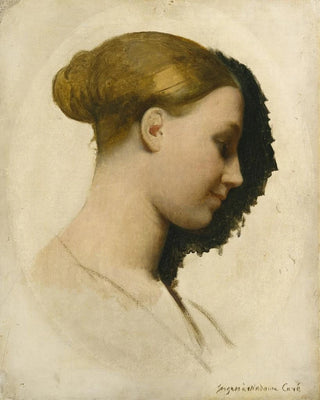Art print | Madame Edmond Cavé Marie-Élisabeth Blavot née en 1810 - Jean-Auguste-Dominique Ingres


View from behind

Frame (optional)
In the fascinating world of 19th-century academic painting, the portrait of Madame Edmond Cavé, created by Jean Auguste Dominique Ingres, stands out as an iconic work that transcends the simple genre of portraiture. Capturing the essence of an era, this masterpiece demonstrates unparalleled craftsmanship and artistic sensitivity that bestow a timeless aura upon the female figure. The painting, which depicts Marie-Élisabeth Blavot, wife of art collector Edmond Cavé, is much more than a mere representation; it embodies the elegance and sophistication of a society in full transformation. Through this work, Ingres manages to combine the precision of drawing with a delicate use of color, offering viewers an immersion into the refined world of the 19th century.
Style and uniqueness of the work
Ingres's style is characterized by meticulous precision and attention to detail, which are fully expressed in the portrait of Madame Cavé. The composition, carefully balanced, highlights the serene and expressive face of the sitter, while the drapery of her dress evokes a sense of movement and texture that captivates the eye. Ingres, master of portraiture, employs a subtle palette that emphasizes the softness of Marie-Élisabeth Blavot's features, while adding an almost sculptural dimension to her face. The flowing lines and delicate contours testify to a refined technique, where each brushstroke seems imbued with palpable emotion. This painting, far from being a simple representation, becomes a true dialogue between the artist and his model, revealing rare intimacy and psychological depth that fascinate the viewer.
The artist and his influence
Jean Auguste Dominique Ingres, an emblematic figure of Neoclassicism, knew how to mark his era with a unique style that combines academic rigor and personal sensitivity. Trained at the French Academy in Rome, Ingres constantly sought to elevate portraiture to the rank of major art, drawing inspiration from old masters while infusing his own vision. His work on Madame Edmond Cavé does not

Matte finish

View from behind

Frame (optional)
In the fascinating world of 19th-century academic painting, the portrait of Madame Edmond Cavé, created by Jean Auguste Dominique Ingres, stands out as an iconic work that transcends the simple genre of portraiture. Capturing the essence of an era, this masterpiece demonstrates unparalleled craftsmanship and artistic sensitivity that bestow a timeless aura upon the female figure. The painting, which depicts Marie-Élisabeth Blavot, wife of art collector Edmond Cavé, is much more than a mere representation; it embodies the elegance and sophistication of a society in full transformation. Through this work, Ingres manages to combine the precision of drawing with a delicate use of color, offering viewers an immersion into the refined world of the 19th century.
Style and uniqueness of the work
Ingres's style is characterized by meticulous precision and attention to detail, which are fully expressed in the portrait of Madame Cavé. The composition, carefully balanced, highlights the serene and expressive face of the sitter, while the drapery of her dress evokes a sense of movement and texture that captivates the eye. Ingres, master of portraiture, employs a subtle palette that emphasizes the softness of Marie-Élisabeth Blavot's features, while adding an almost sculptural dimension to her face. The flowing lines and delicate contours testify to a refined technique, where each brushstroke seems imbued with palpable emotion. This painting, far from being a simple representation, becomes a true dialogue between the artist and his model, revealing rare intimacy and psychological depth that fascinate the viewer.
The artist and his influence
Jean Auguste Dominique Ingres, an emblematic figure of Neoclassicism, knew how to mark his era with a unique style that combines academic rigor and personal sensitivity. Trained at the French Academy in Rome, Ingres constantly sought to elevate portraiture to the rank of major art, drawing inspiration from old masters while infusing his own vision. His work on Madame Edmond Cavé does not






